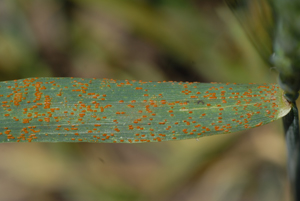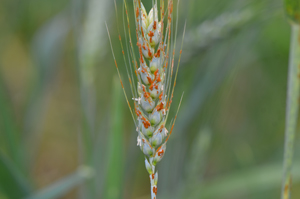G2180
Rust Diseases of Wheat
This NebGuide provides information on leaf, stem, and stripe rust diseases of wheat to help farmers make management decisions.
Stephen N. Wegulo, Extension Plant Pathologist
Emmanuel Byamukama, Post-Doctoral Research Associate
|
Occurrence and Importance
Rusts are among the most important fungal diseases of wheat worldwide. This is due to their wide distribution, capacity to form new races that can attack previously resistant cultivars, ability to move long distances, and potential to develop rapidly under optimal environmental conditions.
Leaf, stem, and stripe rust comprise the three rust diseases of wheat. In the central Great Plains of North America, leaf rust is the most common of the three diseases. Since 2000, stripe rust has increasingly become more common and widespread in Nebraska and other Great Plains states. Stem rust is detected only at trace levels in the central Great Plains because most hard red and hard white winter wheat cultivars grown in the region are resistant to the disease. However, a new race of stem rust known as Ug99 that overcomes the resistance in wheat cultivars grown in the United States and other parts of the world was detected in East Africa in 1998. At least seven races of the Ug99 lineage are now known and have spread to various countries in Africa and the Middle East. Should these stem rust races arrive in the U.S., there will be potential for significant yield losses due to stem rust.
The wheat rust fungi are obligate parasites; that is, they can grow and multiply in nature only on living plant tissue. They are highly specialized in the plant species they parasitize. The complete disease cycle is complicated; two plant hosts (wheat and an alternate host) and several different spore types are required to complete the life cycle. A comparison of the characteristics of the three wheat rusts is presented in Table I.
| Table I. A comparison of the three wheat rusts. | |||
| Leaf rust | Stem rust | Stripe rust | |
| Pustule location | Leaf, mainly on the upper surface | Stem and leaf, upper and lower surfaces of leaf; occasionally on head and seeds | Leaf, upper surface; occasionally on head and seeds |
| Pustule color | Orange-brown | Orange-red to dark-red | Orange-yellow |
| Pustule arrangement | Single and random | Single and random | Stripes |
| Pustule shape and size | Round or slightly elongated; small to medium | Oval shaped or elongated; small to large | Round, blister-like; small |
| Tearing of host epidermis | Rare, visible with magnification | Conspicuous | None |
| Optimum temperature for infection | 59-68°F | 59-84°F | 45-54°F |
| Optimum temperature for disease development | 68-77°F | 79-86°F | 50-59°F |
| Alternate hosts | Meadow rue (Thalictrum sp.); does not play a role in the leaf rust life cycle in the United States | Barberry (Berberis sp.); where present, can play a role in the stem rust life cycle in the United States | Barberry (Berberis sp.); where present, can play a role in the stripe rust life cycle in the United States |
Leaf Rust
Leaf rust, also known as brown rust, is caused by the fungus Puccinia triticina. It is generally distributed throughout eastern and central Nebraska and occurs sporadically in western Nebraska. The disease is most damaging when the upper leaves of infected plants become severely rusted before flowering. Heavy rusting causes early loss of these leaves, which reduces the grain filling period and results in smaller kernel size.
Symptoms. Leaf rust produces orange-brown uredinia (fruiting bodies) in pustules primarily on the upper surface of leaves (Figure 1). The uredinia are round or slightly elongated, erumpent (breaking through the host surface), and do not cause conspicuous tears in the epidermal tissues as do those of the stem rust fungus. Under favorable conditions for disease development, uredinia can cover nearly the entire upper leaf surface. Numerous spores known as urediniospores are formed in the uredinia.
As wheat ripens, the uredinial stage turns into a new stage known as the telial stage. Telia (fruiting bodies similar in size to uredinia) are black and develop beneath the epidermis primarily on leaf sheaths and blades. They produce brown-black spores known as teliospores. Telia are not always formed especially if rust infections occur late in the growing season.
|
Disease cycle and epidemiology. Urediniospores are spread by wind and splashing water. They land on healthy plants and initiate new leaf infections. Optimal conditions for infection are a temperature range of 59-68°F and at least six hours of free moisture on the leaf surface. Under optimal conditions for disease development (wet weather and temperatures ranging from 68-77°F), new uredinia are formed within 7 to10 days after infection and the cycle of spore production is repeated. Therefore, the urediniospore is the repeating spore of the leaf rust fungus. Teliospores can survive the winter. They play an important role in the disease cycle only in regions of the world where alternate hosts of the leaf rust fungus exist. There are no known alternate hosts of the leaf rust fungus in the U.S. Therefore, teliospores are not epidemiologically important as are urediniospores. The leaf rust fungus survives the winter as mycelium or uredioniospores on volunteer or overwintering wheat crops in the southern states and Mexico. In the spring, urediniospores are blown north into the central and northern Great Plains along a pathway commonly known as the Puccinia pathway (Figure 2). In Nebraska, leaf rust is usually first detected in May. However, in years with mild fall and winter temperatures, P. triticina has been observed to overwinter in Nebraska and Kansas. If overwintering occurs, leaf rust can be detected much earlier in the growing season.
Economic importance. Leaf rust can cause significant yield losses. In 2007, severe epidemics of leaf rust in the Great Plains of North America caused yield losses of up to 14 percent. These losses can exceed 50 percent locally depending on favorable environmental conditions for disease development, onset of disease early in the growing season, and cultivar susceptibility.
Stem Rust
Stem rust, also known as black rust and black stem rust, is caused by the fungus Puccinia graminis f. sp. tritici. This fungus also infects some barley and rye cultivars as well as certain grasses including goatgrass and wild barley. Stem rust is historically an important disease of wheat. In Roman times, the importance of stem rust on wheat and barley production was noted by various authors. In the U.S., several major epidemics of the disease occurred from 1916 to the early 1950s, causing billions of dollars in losses. Stem rust is capable of destroying entire wheat fields over a large area within a period of just a few weeks.
Symptoms. On wheat, uredinia (pustules) are formed on stems, leaves, and leaf sheaths (Figures 3 and 4). Occasionally they are formed on awns and glumes (Figure 5) as well as seeds. Uredinia are orange to dark red in color and form on both surfaces of leaves. They are elliptical to elongate and are larger than those of leaf rust and stripe rust. They cause conspicuous tears in the epidermal tissues, giving the margins a tattered appearance (Figure 2). Numerous urediniospores are released from young pustules. Later in the growing season, uredinia convert to telia by producing dark colored, overwintering teliospores, hence the name black rust. Severe infections weaken stems, leading to lodging and shriveled, prematurely ripened grain. On barberry, the alternate host, raised yellow-orange fruiting bodies known as aecia (singular: aecium) form on the underside of leaves. They produce spores known as aeciospores.
Disease cycle and epidemiology. P. graminis f. sp. graminis overwinters in the southern states and Mexico. During the growing season, urediniospores are blown north by wind (Figure 2). They land on healthy wheat plants and initiate new infections. Of the three wheat rusts, stem rust has the warmest temperature requirements. Optimal conditions for infection are a temperature range of 59-84°F and six to eight hours of free moisture on the leaf surface. Under optimal conditions for disease development (wet weather and a temperature range of 79-86°F), new uredinia are formed within a period of 7 to 10 days after infection. In the field, they are spread by wind and splashing water. Several cycles of urediniospore production occur during the growing season. In the spring, germination of overwintered teliospores (released by telia that developed on wheat late in the previous year’s growing season) leads to formation of a special mycelium known as a basidium. The basidium produces spores called basidiospores that are spread by wind and infect barberry, the alternate host. Infection of barberry results in the formation of aecia on the lower surfaces of leaves. Aeciospores produced by aecia are spread by wind, infect wheat, and give rise to uredinia, completing the life cycle. Due to the eradication of barberry in most wheat growing regions in the U.S., urediniospores (repeating spores) are the major source of stem rust infections and spread. Due to the warm temperature requirements, stem rust is usually first detected in Nebraska in June.
Economic importance. Stem rust is capable of causing 100 percent yield loss. The degree of loss depends on favorable environmental conditions, cultivar susceptibility, and the time of disease onset during the growing season. Earlier disease onset results in more severe yield loss. In 1953 and 1954, total losses to wheat stem rust in the U.S. over the two years were estimated at 169 million bushels valued at $2.6 billion.
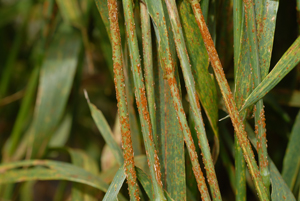 |
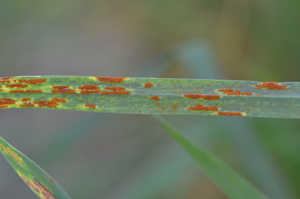 |
|||
| Figure 3. Stem rust on wheat stems and leaves. | Figure 4. Close-up of stem rust on the lower surface of a wheat leaf. | |||
|
||||
Stripe Rust
Stripe rust, also known as yellow rust, is caused by the fungus Puccinia striiformis f. sp. tritici. Before 2000, stripe rust in the U.S. occurred mainly in the Pacific Northwest and California. Since 2000, it has become increasingly common in the south central and central Great Plains. The most recent notable epidemics of stripe rust in Nebraska occurred in 2010 and 2012.
Symptoms. Initial symptoms are chlorotic patches on leaves. Yellow to orange uredinia develop in these patches and form distinct stripes on mature, upper leaves (Figure 6). Under favorable environmental conditions, entire leaf surfaces can be covered with stripes. Distinct stripes do not form on seedling leaves. Stripes or necrotic spots vary in size depending cultivar resistance and environmental conditions. Uredinia can form on glumes on the wheat head, and occasionally immature grain can be infected. Rapid desiccation of the entire plant can occur due to utilization of water and nutrients by the stripe rust pathogen. Later in the growing season, dark brown to black telial pustules develop under the epidermis and form streaks on the leaves (Figure 7) and leaf sheaths. Under natural field conditions, it is common to find wheat co-infected with stripe rust and leaf rust (Figure 8) or stem rust and leaf rust.
Disease cycle and epidemiology. The stripe rust fungus overwinters as mycelium and/or urediniospores on volunteer wheat or overwintering wheat crops in regions with mild winters. In the central and northern Great Plains of the U.S., urediniospores originate mainly from the southern states and Mexico and are blown northward by wind (Figure 2). In Nebraska, stripe rust is usually first detected in April. However, like leaf rust, stripe rust can overwinter in Nebraska in years with mild fall and winter temperatures, which can lead to detection as early as the beginning of the growing season in April. Of the three wheat rusts, stripe rust has the lowest temperature requirements. Optimal conditions for infection are temperatures between 45 and 54°F and eight hours of free moisture on the leaf surface. Optimal conditions for disease development are a temperature range of 50-59°F and intermittent rain or dew. Under optimal conditions for disease development, new uredinia are formed within a period of 7 to 10 days after infection. Several cycles of urediniospore production occur during the growing season. Until recently, no alternate host for the stripe rust fungus had been identified. In 2009, plant pathologists at the Cereal Disease Laboratory in St. Paul, Minn., demonstrated that barberry (Berberis sp.) is an alternate host for the stripe rust fungus. Therefore, in the presence of barberry, the fungus can undergo a complete life cycle as described above for the stem rust fungus.
Economic importance. Yield losses of up to 40 percent due to stripe rust have been reported in susceptible wheat cultivars. In experimental fields, yield losses of up to 74 percent have been documented. Total loss can occur in susceptible cultivars if disease onset is early in the growing season and favorable environmental conditions (wet, cool weather) prevail.
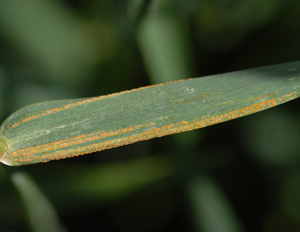 |
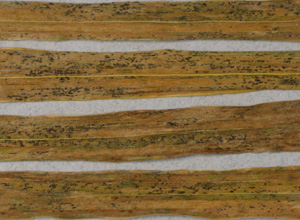 |
|
| Figure 6. Stripe rust on a wheat leaf. | Figure 7. Stripe rust telia on the lower surfaces of wheat leaves. | |
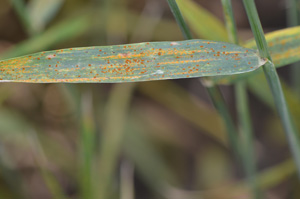 |
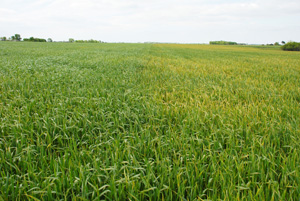 |
|
| Figure 8. A wheat leaf co-infected with leaf rust and stripe rust. | Figure 9. Stripe rust in a wheat field planted with a susceptible cultivar (right) and a moderately resistant cultivar (left) in south central Nebraska in 2010. Cultivar complementation is a recommended strategy for management of wheat diseases. |
Management of Wheat Rusts
Wheat rusts can be managed by planting resistant cultivars. However, due to the emergence of new races of the rust fungi, the resistance present in current cultivars can be overcome. Planting several cultivars differing in genetic and agronomic characteristics (e.g. disease resistance and time of maturity), known as cultivar complementation, can help to avoid total loss in years with severe rust epidemics. Figure 9 shows two wheat cultivars differing in stripe rust susceptibility planted side by side in a field in south central Nebraska in 2010.
Foliar fungicides can be applied during the growing season to control rust diseases. Table II contains a list of foliar fungicides registered in Nebraska for use on wheat. The decision to apply a fungicide and the timing of fungicide application should be based on the following risk factors: a mild winter which increases the probability of rust overwintering in Nebraska; susceptibility of the wheat cultivar planted; progression of rust from southern states; wheat growth stage; and rust-favorable (wet) weather forecasts. The more favorable conditions are for rust development, the higher the return on investment in a fungicide application.
For optimal timing of foliar fungicide application, scout fields routinely starting in April for early disease detection. Monitor the weather and the movement of rust diseases northward from southern states. If moderate to severe levels of rust are reported in Kansas and wet weather is forecast, it is likely that rust will develop to damaging levels in Nebraska wheat fields. Fungicide application should be aimed at protecting the flag leaf. However, it may be necessary to apply a fungicide earlier than flag leaf emergence if stripe rust develops early in the growing season and conditions are favorable for its spread. Additional strategies for management of rust diseases of wheat include cultural practices such as controlling volunteer wheat and avoiding excessive fertilization and irrigation.
| Table II. Fungicides registered for use on wheat to control foliar diseases1. | |||||
| Fungicide trade name2 | Active ingredient | Fungicide class | Rate (per acre) |
Re-entry interval (REI) (hours) |
Pre-harvest interval (PHI) (days) |
| Absolute | tebuconazole + trifloxystrobin | triazole + strobilurin | 5.0 fl oz |
24 |
35 |
| Alto | cyproconazole | triazole | 3.0-5.5 fl oz |
12 |
30 |
| Bumper | propiconazole | triazole | 4.0 fl oz |
24 |
40 |
| Caramba | metconazole | triazole | 10.0-14.0 fl oz |
12 |
30 |
| Evito | fluoxastrobin | strobilurin | 2.0-4.0 fl oz |
12 |
Apply no later than Feekes 10.5 (full heading) |
| Folicur | tebuconazole | triazole | 4.0 fl oz |
12 |
30 |
| Headline | pyraclostrobin | strobilurin | 6.0 fl oz |
12 |
Apply no later than Feekes 10.5 |
| ManKocide | Mancozeb + copper hydroxide | Dithiocarbamate + inorganic | 1.7 lb |
48 |
Apply no later than Feekes 10.5 |
| Muscle | tebuconazole | triazole | 4.0 fl oz |
12 |
30 |
| Orius | tebuconazole | triazole | 4.0 fl oz |
12 |
30 |
| Priaxor | fluxapyroxad + pyraclostrobin | carboxamide + strobilurin | 8.0 fl oz |
12 |
Apply no later than Feekes 10.5 |
| Proline | prothioconazole | triazole | 4.3-5.7 fl oz |
12 |
30 |
| PropiMax | propiconazole | triazole | 2.0-4.0 fl oz |
24 |
40 |
| Prosaro | prothioconazole + tebuconazole | triazole + triazole | 6.5-8.2 fl oz |
12 |
30 |
| Quadris | azoxystrobin | strobilurin | 6.0-15.5 fl oz |
4 |
Apply no later than Feekes 10.5 |
| Quilt | propiconazole + azoxystrobin | triazole + strobilurin | 10.5-14.0 fl oz |
12 |
Apply no later than Feekes 10.5 |
| Quilt Xcel | azoxystrobin + propiconazole | strobilurin + triazole | 10.5-14.0 fl oz |
12 |
Apply no later than Feekes 10.5 |
| Stratego | propiconazole + trifloxystrobin | triazole + strobilurin | 10.0 fl oz |
12 |
Apply no later than Feekes 10.5 |
| Stratego YLD | prothioconazole + trifloxystrobin | triazole + strobilurin | 4.0 fl oz |
12 |
Apply no later than Feekes 10.5 |
| Tebuzol | tebuconazole | triazole | 4.0 fl oz |
12 |
30 |
| Tilt | propiconazole | triazole | 2.0-4.0 fl oz |
12 |
30 |
| Toledo | tebuconazole | triazole | 4.0 fl oz |
12 |
30 |
| TwinLine | pyraclostrobin + metconazole | strobilurin + triazole | 7.0-9.0 fl oz |
12 |
Apply no later than Feekes 10.5 |
| Vertisan | penthiopyrad | carboxamide | 10.0-24.0 fl oz |
12 |
Apply no later than Feekes 10.5.1 (flowering) |
| 1This list is presented for information only and no endorsement is intended for products listed or criticism meant for products not listed. Consult the product label before buying and using a specific fungicide. Read and follow all label directions and restrictions. 2The label on most of the products listed in Table II recommends adding a spreader sticker and applying in sufficient water to ensure good coverage. This publication has been peer reviewed. |
|||||
This publication has been peer reviewed.
Visit the University of Nebraska–Lincoln Extension Publications website for more publications.
Index: Plant Diseases
Wheat
Issued November 2012
